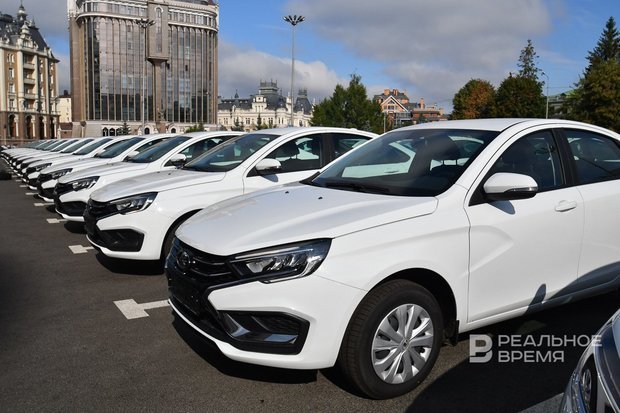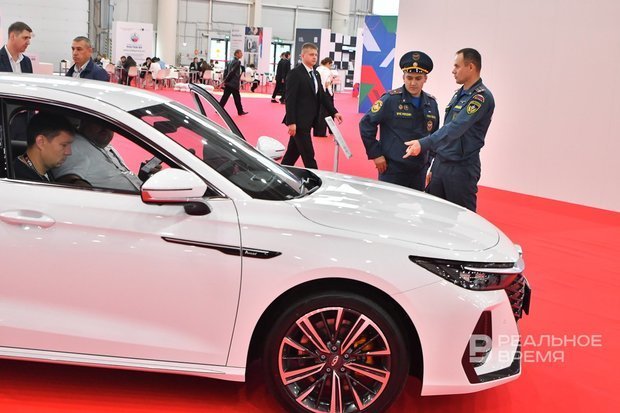Back to the past: Tatarstan citizens massively switching to Lada

Sales of new cars in Tatarstan have increased by 75.3% for ten months of 2023. At the same time, the share of foreign cars in sales decreased from 64.5% to 55.4%, and the share of domestic cars increased from 35.5% to 44.6%. Lada is still in the lead. AvtoVAZ is trying to move Chinese brands off the pedestal, the number of which on the market has almost tripled in a year. Trends of 2023 and forecasts for 2024 are in the review of the analytical service of Realnoe Vremya.
AvtoVAZ in the lead
In 10 months of 2023, 32,738 new passenger cars were sold in Tatarstan — this is by 75.3% more than in the same period of 2022, Alexander Klimnov, an expert at Autostat Info, told Realnoe Vremya. Against the background of sanctions and the withdrawal of foreign brands, the share of domestic brands in sales increased from 35.5% to 44.6% — up to 14,615 cars. The share of foreign cars decreased from 64.5% to 55.4% — to 18,123 units.
Lada is the leader among the car brands in Tatarstan (13,884 cars were sold), which is 2.1 times more than last year. AvtoVAZ is being actively squeezed by the Chinese in the market — 11.7 thousand cars from China have been sold in the republic in 10 months — these are the brands such as Chery (3,105 units), Haval (2,991), Geely (1,523), Exeed (1,019), Omoda (975), and Changan (727), etc.
The once popular Hyundai and Kia are losing their positions, their share in sales has decreased, according to Autostat Info, by 16.7% and 21.8%, respectively. Moskvich also got into the top 10 popular brands — 545 cars of this brand have been sold in Tatarstan in 10 months.
According to Autostat Info, 1.88 trillion rubles were raised from the sale of passenger cars in the first nine months of 2023.

China continues to advance
In fact, Chinese brands have so far captured the Russian market primarily in the SUV (crossover) segment, Klimnov notes. Their share in the Russian market for 10 months of 2023 amounted to 403.9 thousand units, or 49.1% of the market (and 74.3% among foreign cars) against 15.5% and 21.3%, respectively, a year earlier.
In Tatarstan, the share of “Chinese” reached 35.7% (11.7 thousand cars) against 10.6% (2 thousand) in 2022. Moreover, there were only 6 Chinese brands in the top 30 brands a year ago, while this year, there are already 17, or more than half.

“The Russian brands Evolve and Moskvich, in fact, represent a purely “Chinese screwdriver," says Klimnov. “But their localisation, though not without problems, is going on: for example, welding and painting of bodies have been mastered at Moskvich. And the difference with imported Chinese brands is primarily that they are considered Russian products by VIN, which means they are admitted to tenders for the purchase of Russian legal entities, including various departments, that is, domestic officials can only drive such new cars.
The main trends of 2023 are the restoration of the car market and the replacement of foreign cars of European, Korean and Japanese brands with Chinese and Russian ones.
Top 3 in TTS — Lada, Chery, and Haval
For 10 months of 2023, the sales of new cars in TransTechService (TTS) increased by 27% compared to the same period last year, sales of used cars increased by 44%, Ruslan Shaykhlislamov, the commercial director of the Kazan division of TransTechService Group, told Realnoe Vremya.
If Lada, Kia and Renault were in the top sales in 2022, then in 2023 — Lada, Chery, and Haval.

Lada cars are also in the lead among cars with mileage in 2023. Kia and Hyundai are in second and third place.
“The availability of cars in warehouses and the goals set by importers of new cars for 2024 indicate that the probability of growth of the automotive market next year is high," Shaykhlislamov notes. “Auto business analysts also forecast sales growth for 2024 compared to 2023. Many brands have become more recognisable, and this contributes to greater trust on the part of customers and, as a result, sales growth.

Sales in 2024, in his opinion, will be influenced by the following factors: support programmes from importers, entry into the market of new cars, the policy of the Central Bank of Russia at the key rate, exchange rates to the ruble and the availability of cars on the market.
Top 3 in KAN AUTO — Lada Granta, Lada Vesta, and Kia Rio
KAN AUTO Group of Companies sold 21,786 cars in 10 months of 2023. Compared to the same period in 2022, sales increased by 66.8%, Rita Khalilova, the sales director of KAN AUTO Group, told Realnoe Vremya.
The sales of new cars in 2023 increased by 60.1%, and sales of used cars — by 65.2%.
According to the results of 10 months, only one model from China was included in the top-5 in the KAN AUTO Group of Companies. Almost the entire top was occupied by cars of domestic and Korean brands — Lada Granta, Lada Vesta, Kia Rio, Hyundai Solaris, Hyundai Creta and Haval Jolion.

Logistics is fine-tuned, consumers have recovered from the first shocks
The change in the domestic automotive market may be due to several reasons, says Dmitry Baranov, a leading expert of the Finam Management Management Company.

An important factor, according to him, is the deferred demand for cars: consumers did not know how the situation would develop, and postponed their purchase last year.

In 2024, the domestic car market will grow, but probably stepwise — a few months of growth, then a respite, during which manufacturers and consumers will get used to the new state of the market, and then growth again, predicts Baranov.
The appearance of new car brands in the domestic car market is not excluded, but it is unlikely that there will be many of them, rather we can expect the appearance of new models in 2024 from already well-known car brands.